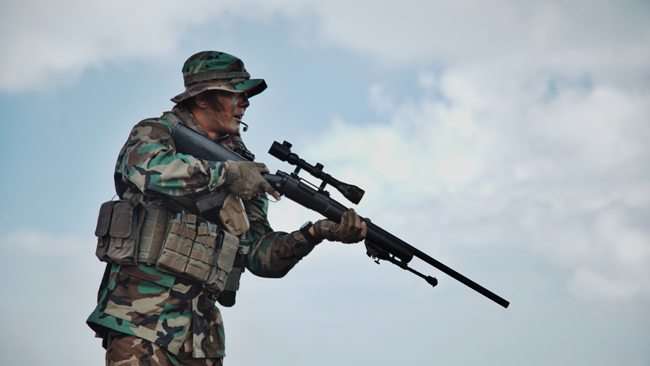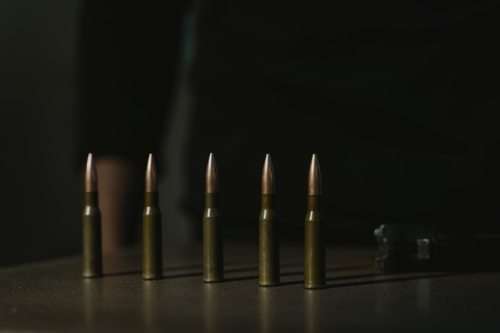Newbies in the hunting field are often confused and stuck with choosing their first gun, as there are many factors you must consider to choose a suitable one.
Understanding your concern, we have come up with this article to provide you with useful information about important factors and steps on How to choose the first rifle for beginner?
Kick in it right now!

Contents
6 Steps On How To Choose The First Rifle For Beginner
After you’ve decided to purchase your first gun, the real job begins. So what exactly should you get? Here are six steps that might assist you in selecting your new tool.
Step 1: Determine Your Purpose
First and foremost, you should know the purpose that the gun will be used for before selecting one. Will you use it for target shooting, hunting, or self-defense? Will it be utilized at close range or a distance? The decision gets a lot easier after you’ve decided how you’ll utilize your first rifle.
You can possibly get a multi-purpose rifle like a firearm. Overall, when choosing your first handgun, narrowing down your objective may be quite helpful.

Step 2: Decide How Much You Want To Spend
Price is also a huge issue, especially for beginners.
For hunting purposes, the Mosin Nagant is an excellent rifle at a reasonable price. It was the Russian army rifle during WWII, and you can find them at gun and knife exhibitions all across the country. They’re generally available for less than $100, including tax. Besides, it’s also quite cheap to buy ammunition for it or buy it in bulk on the Internet for the cheapest price.
The SKS rifle is, without a doubt, the most cost-effective personal defense firearm available. In detail, it will cost you approximately $300 before taxes. Even in adverse situations, this rifle is incredibly accurate and dependable. It’s also really easy to maintain.
Be willing to do some comparison shopping. Believe it or not, you can frequently discover a better bargain by researching stores and sources. For example, a gun and knife exhibition seller once tried to sell a Mosin Nagant for $350, whereas another seller not far away was selling the identical rifle for $99.
If you have a limited budget, buying a second-hand rifle is also a good idea. However, do not forget to double-check the paperwork and take the gun to a gunsmith to ensure it’s in excellent operating condition before firing it!
Read more: 7 Simple Ways of How to Check If a Gun is Stolen
Step 3: Choose An Action

- Semi-automatic:
The primary purpose of these weapons is for self-defense. The bolt cycles when the rifle fires, ejecting the spent case and chambering a new round. They fire at the quickest pace and contain a detachable or internal magazine that feeds ammo.
Because semi-automatic rifles might be sensitive to different types of ammunition based on the quantity of gunpowder and bullet weight, it’s critical to carefully examine the ammo you want to use before inserting them in the gun.
- Bolt-action:
A bolt-action rifle is extremely accurate and ideal for hunting or long-range shooting. However, their magazines often have a limited capacity that can carry only a few bullets. Some have detachable magazines, while others have an internal magazine box.
Moreover, the spent case is ejected from these rifles by drawing back the bolt, which is then pushed forward to put in a fresh cartridge. Bolt-action rifles are excellent candidates for sound suppressors due to the sealed action that is manually cycled.
- Lever-action:
A lever-action rifle is ideal for hunting and range enjoyment. It even has its competitive shooting branch. Personal protection is also possible with this type.
Furthermore, lever-action guns use a tube magazine that runs beneath the barrel to supply ammo. These magazines take longer to reload, but they are mastered in practice.
- Slide-action
Slide-action, sometimes known as pump-action, is no longer as popular as it once was. This rifle is similar to a lever-action rifle in operation or application, but a pump instead of a lever drives the action.
The pump is pulled forward to load new ammunition and pushed back to expel spent casings. They’re fantastic for hunting, but they may also be used for defense if necessary. Additionally, the pump system is a relatively simple and dependable device that will work in most situations.
- Break-action:
Single-shot break-action rifles are commonly used for target hunting, shooting, or eliminating undesirable animals. Multi-barrel models and some chambered for various calibers are also available, but they are less popular. Because these rifles are less expensive to manufacture, you can find them at a very low price.
Step 4: Choose The Caliber

After finishing the two above steps, it’s time to choose a caliber! There are numerous production calibers and several advanced calibers available for handloading, yet you should stick with the one that is widely accessible for your first gun. Each caliber has advantages and disadvantages; please consider carefully and choose a cartridge that is appropriate for your needs.
Step 5: Choose The Length Of Barrel
Firstly, you have to select the length of your barrel. For particular calibers and purposes, there are ideal barrel lengths.
Longer barrels provide greater pressure to build up during the cartridge’s discharge, allowing the bullet to travel faster. This factor improves long-range precision and ballistic efficiency. But, in return, it will make the rifle heavier and more difficult to control.
Shorter ones allow several calibers to survive since the powder does not require any extra length to burn.
It’s critical to understand the impact of barrel length on the caliber you choose so that you may get the most out of the rifle.
Step 6: Consider Other Factors

Let’s look for other factors that may affect your decision!
- Weight
Your first rifle weight may be an issue. If you’re going to carry the gun around for hunting or hiking, you’ll want something that’s not too heavy. On the other hand, something hefty may be a better alternative if you only want to fire tiny groups at a range bench.
Just keep in mind that the rifle’s weight will assist in absorbing some of the recoils. Also, a big caliber in a lightweight gun will offer more kick.
- Attachments
If you’re choosing a rifle for self-defense, you’ll most likely want to be able to add lasers, lasers, and front grips. The difficulty level is determined by the firearm you choose. Many rifles come with rails or parts for mounting attachments out of the box, while others will need to be modified.
- Maintenance
Certain types of rifles need more additional maintenance. Similarly, some platforms are simpler to dismantle and clean than some others.
The firing mechanism of a break/bolt-action rifle is very basic, making cleaning and lubricating a snap. Meanwhile, some semi-automatic weapons are more complicated than others.
We do not say that you should not choose anything challenging because you can learn and practice to use it. Just be aware of your limitations and conduct some research to ensure you understand what you’re getting yourself into.
Additionally, try the product before you purchase it. Some public shooting ranges lend out weapons for you to test out.
Conclusion
We hope that you now have a satisfactory answer to How to choose the first rifle for beginner?
Be patient and take the time to consider the factors we have mentioned above before owning one. Apart from main factors such as purpose, budget, action, caliber, and barrel length, please also note three additional weight, attachment, and maintenance aspects.
Good luck!

I am Jerry Gonzalez, and my heart beats for the great outdoors, especially in the breathtaking landscapes of Helena, Montana. Engaging with fellow enthusiasts online and at local hunting clubs has been a rewarding experience, and I find great joy in sharing knowledge and experiences with like-minded individuals. My goal is to empower my fellow hunters with well-informed choices, regardless of their experience level.
